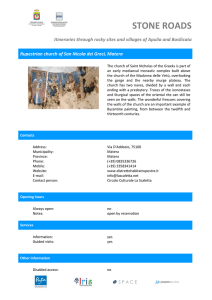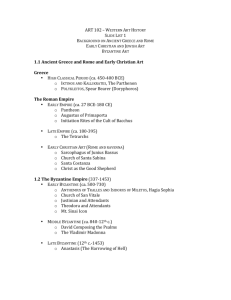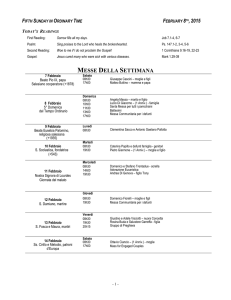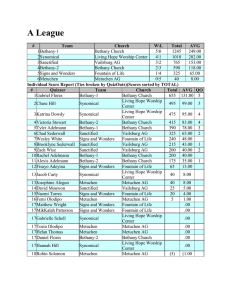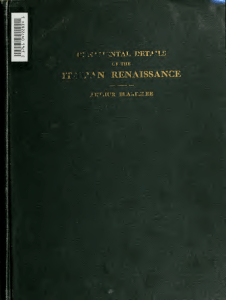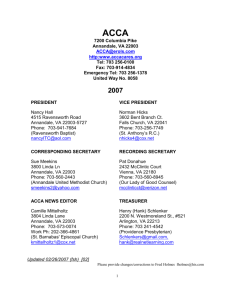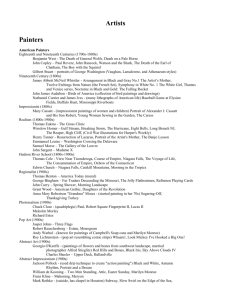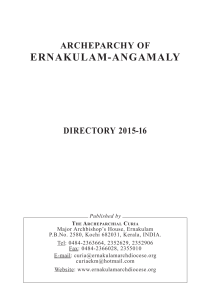Podestà Palace (1255)
advertisement
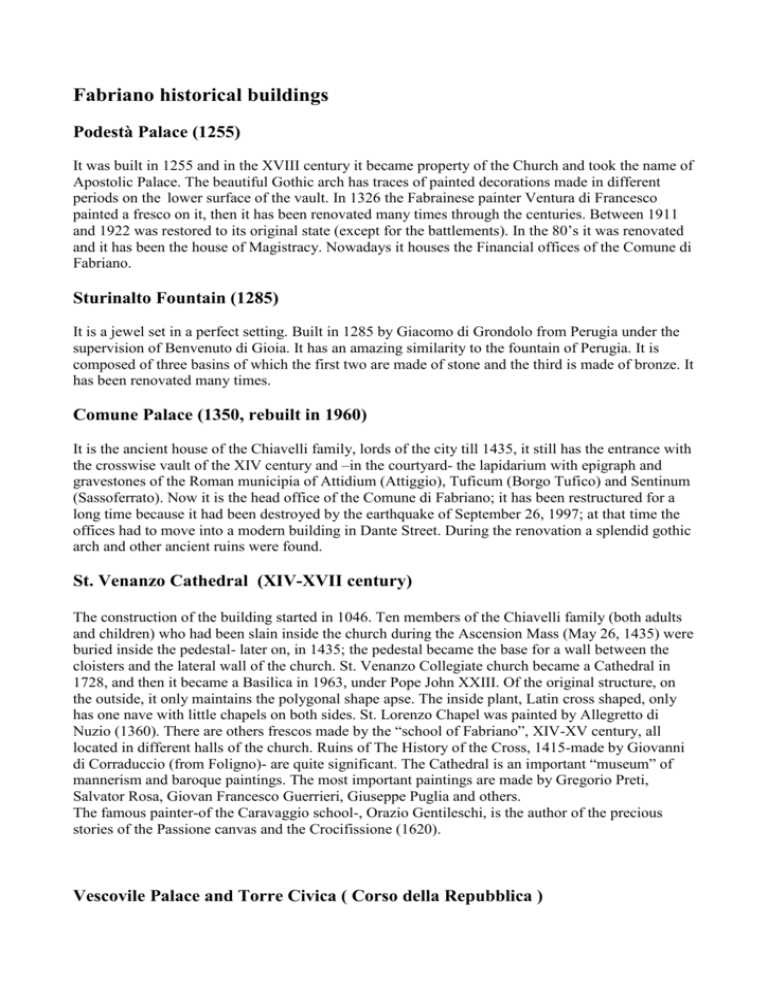
Fabriano historical buildings Podestà Palace (1255) It was built in 1255 and in the XVIII century it became property of the Church and took the name of Apostolic Palace. The beautiful Gothic arch has traces of painted decorations made in different periods on the lower surface of the vault. In 1326 the Fabrainese painter Ventura di Francesco painted a fresco on it, then it has been renovated many times through the centuries. Between 1911 and 1922 was restored to its original state (except for the battlements). In the 80’s it was renovated and it has been the house of Magistracy. Nowadays it houses the Financial offices of the Comune di Fabriano. Sturinalto Fountain (1285) It is a jewel set in a perfect setting. Built in 1285 by Giacomo di Grondolo from Perugia under the supervision of Benvenuto di Gioia. It has an amazing similarity to the fountain of Perugia. It is composed of three basins of which the first two are made of stone and the third is made of bronze. It has been renovated many times. Comune Palace (1350, rebuilt in 1960) It is the ancient house of the Chiavelli family, lords of the city till 1435, it still has the entrance with the crosswise vault of the XIV century and –in the courtyard- the lapidarium with epigraph and gravestones of the Roman municipia of Attidium (Attiggio), Tuficum (Borgo Tufico) and Sentinum (Sassoferrato). Now it is the head office of the Comune di Fabriano; it has been restructured for a long time because it had been destroyed by the earthquake of September 26, 1997; at that time the offices had to move into a modern building in Dante Street. During the renovation a splendid gothic arch and other ancient ruins were found. St. Venanzo Cathedral (XIV-XVII century) The construction of the building started in 1046. Ten members of the Chiavelli family (both adults and children) who had been slain inside the church during the Ascension Mass (May 26, 1435) were buried inside the pedestal- later on, in 1435; the pedestal became the base for a wall between the cloisters and the lateral wall of the church. St. Venanzo Collegiate church became a Cathedral in 1728, and then it became a Basilica in 1963, under Pope John XXIII. Of the original structure, on the outside, it only maintains the polygonal shape apse. The inside plant, Latin cross shaped, only has one nave with little chapels on both sides. St. Lorenzo Chapel was painted by Allegretto di Nuzio (1360). There are others frescos made by the “school of Fabriano”, XIV-XV century, all located in different halls of the church. Ruins of The History of the Cross, 1415-made by Giovanni di Corraduccio (from Foligno)- are quite significant. The Cathedral is an important “museum” of mannerism and baroque paintings. The most important paintings are made by Gregorio Preti, Salvator Rosa, Giovan Francesco Guerrieri, Giuseppe Puglia and others. The famous painter-of the Caravaggio school-, Orazio Gentileschi, is the author of the precious stories of the Passione canvas and the Crocifissione (1620). Vescovile Palace and Torre Civica ( Corso della Repubblica ) The building, destroyed on May 20, 1542, after the collapse of the belfry (torre civica), was rebuilt between 1546 and 1549. At first it was the centre of the Prior and then it became the centre of the Bishop (1729). The memorial tablet on the facade of the tower, which sings the praises of Italian unification, is a fabrication of history. It was replaced in the post-war period, it was meant to be the copy of the majestic one that had been framed in 1884, but at the moment of copying it a mistake was made: they wrote MDCCCLXXXVI instead of MDCCCLXXXIV. The present memorial tablet is smallest than the previous one. Loggiato S. Francesco (Corso della Repubblica) It was renamed Loggiato XX Settembre, it is the reconstruction of the fifteenth-century portico built next to the Church of St. Francesco, finished in the end of XVIII century. The fourteenth-century church was demolished in 1864, because it was unsafe. Of this church we still keep a ceiling with fourteenth-century fresco and a portal for round-arched Gothic style with twisted columns, visible from the porch. Another portal is visible on the front of the church. Church of St. Benedetto (piazza F. Altini) Founded in 1244 by S.Silvestro (Guzzolini) it was enlarged in 1290 and rebuilt in 1590. After the earthquake in 1741 the church was rebuilt again. Of the original structure there are few ruins. The wooden seats of the choir (in where the Chiavelli were slain) are valuable traces of the Florentine carving of the late Gothic period. There is a precious stone sculpture of Martino da Cingoli (end of XIII century) representing Beato Giovanni dal Bastone and the pictorial works by Simone de Magistris, Orazio Gentileschi, Pasqualino Rossi, Giacinto Brandi and other painters of the '500 and ‘700. Oratory of Gonfalone The Oratory has an impressive interior with a splendid panelled ceiling, carved and decorated in fine gold by the French sculptor Leonardo Scaglia in the beginning of ‘600. On the walls there is a series of canvas dedicated to the life of the Virgin Mary, made by Francesco Bastari (beginnings of XVII century). Oratory of the Charity (1587/97) The Oratory was decorated in the end of XVI century with a series of valuable frescos made by the mannerist Filippo Bellini (from Urbino). These frescos represent the Spiritual and Corporal Works of Mercy. The Gothic portal stone comes from the former monastery of St Antonio outside the Walls. Madonna del Buon Gesù- Our Lady of Good Jesus (piazza della Cattedrale/via del Poio) The estate, built in 1456 by the will of St.Giacomo della Marca, was first used as a hospital (Ospedale degli Esposti) and then as children's homes (1784). The name of the original church was St. Mary of Good Jesus. The building is a fine example of late Gothic architecture; inside there is the valuable banner of Our Lady of Good Jesus (protector of natural disasters), painted around 1460 by Master of Staffolo. The same painter made frescos visible on the porch. In the nearby Church there are frescoes of Andrea Boscoli (from Florence), painted in the early XVII century. The characteristic stone well in the cloister is dated 1483. Church of St. Domenico (Largo f.lli Spacca) In 1365 Dominicans renovated and enlarged the church of St. Domenico (that was dated XIII century), they dedicated it to St. Lucia Novella; it was rebuilt in 1741. The external side of the church maintains the Gothic style, characterized by the polygonal shape apse- on which there is the emblem of the Chiavelli family-. The Gothic chapels and the sacristy have vast and remarkable decorations made by Allegretto di Nuzio and his school (second half of XIV century). Inside the Convent of St. Domenico (now used as “Paper and Watermarks Museum”) there are two fifteenth century valuable cloisters and, inside, in the chapter house, there is an important decoration made by Antonio da Fabriano in 1480. For the iconography of this decoration the painter took inspiration from the decoration of the Dominican Convent of S. Marco in Florence, designed by Beato Angelico. Church of St. Nicolò (piazza Cairoli) Nowadays there’s no trace of the ancient building founded by the Benedictines between XII-XII centuries. The earthquake of 1279 destroyed the building, which was rebuilt and expanded shortly after. Reconstruction "ex novo" of the church was completed in the last decades of the century XVII. The upper loggia of the facade with three arches is valuable. Of the medieval church remains a fresco of Francescuccio di Cecco Ghissi and the important fourteenth-century wooden sculpture depicting St. Nicola of Bari, created by the Master of the Magi di Fabriano. The church boasts the richest and most important collection of Mannerist and Baroque paintings, such as those by Filippo Bellini, Andrea Sacchi, Giacinto Brandi and Guercino. The elegant cloister is Baroque as well. Church of Saints Biagio and Romualdo (Piazza Manin) Mentioned in a document of 1210 was elevated to Abbey in 1406 under Pope Innocent VII. At first it was dedicated only to S. Biagio, then, after the transfer of the body of S. Romualdo in the church, it assumed the title of Saints Biagio and Romualdo. Inside, there are interesting paintings of Pasqualino Rossi and the Organ of Gaetano Callido (1790). Inside the crypt it is preserved the marble sarcophagus with the relics of St. Romualdo, founder of Camaldolese. There is a remarkable Cloister in Renaissance style. The church was rebuilt several times over the centuries and reached its peak in XVII century. After the earthquake of 1741 suffered heavy damage. After having been damaged again by the earthquake of 26 September 1997,they took specific safety measures and then the church was reopened to cult. Church of St. Onofrio (or Holy Stair) It preserves an impressive wooden crucifix of the end of the ‘300, of German school; a fifteenth century sculpture representing the “Ecce Homo” and a fresco of XV century of the Maestro di Staffalo. The church has a remarkable religious importance because it preserves some portions of the Holy Stairs of Rome Church of St. Caterina (via S. Caterina) The construction started in 1383 for the will of Friar Giovanni di Bartolomeo, Monaco silvestrino, on a land offered by the noblewoman Farratoni, widow of Count Ugo Degli Atti di Sassoferrato. The monastery acquired importance thanks to donations and the protection of Chiavelli. The beautiful cloister was built in sec. XV, whereas the church was completely rebuilt in the early XVII century. Church of St. Maria Maddalena (XIV century, rebuilt in 1858) Just beyond the ancient fortified walls of the city, of which few traces remain, there is the church of St Maria Maddalena, in the beginning a chapel of a hospital (1310). Later it became the spiritual nucleus of the Guild of paper manufacturers, who had obtained a miracle in 1599. The Church is worth visiting for two paintings by the Master of Campodonico and the beautiful Penitent Magdalene of Gentileschi. Portico of the Vasaris (1316) The Portico is a portion of an ancient hospital placed in Market Square (Piazza del Mercato, now Piazza Garibaldi); it was the economic centre of the city during the middle age. On the façade it still has stone emblems of Arte dei Calzolai (art of shoemaker) and also a fresco by a pupil of Allegretto di Nuzio (end of ‘300). On the opposite site there is the valuable Fountain of the square (second half of XV century). Pharmacy Museum Mazzolini Giuseppucci Placed in Corso Della Repubblica, the Museum is dedicated to one of the most important historical Pharmacies in Italy. The spectacular wooden furnishings made in 1896 by Adolfo Ricci (from Perugia), represent the greatest scientists and the greatest discoveries of the nineteenth century. The original collection of porcelain- designed by Ginori- and glass is fully preserved and exposed. The museum is the centre of numerous educational activities related to dissemination of the history of science. Church of St. Augustine (XIII century, rebuilt in 1768) On the right side it still keeps the ancient Gothic portal, decorated with slender columns and capitals decorated with ornamental motifs. The interior is enlivened by vivid eighteenth-century stuccowork of the Swiss Giacomo Cantoni and by some large paintings of Cades. The two chapels on both sides of the main altar represent a great importance for the Gothic painting of the Marche. Stories of St. Augustine are painted on the right, while the opposite one has scenes from the life of Christ and Mary Magdalene. Apparently the two cycles are painted by different authors but the style seems to be connected to the Rimini-Assisi school, of the mid-fourteenth century. In the cloister of the church, now outbuilding of the Civil Hospital, there is the oratory of Beati Becchetti, of late-Gothic style, which altar wall is entirely covered with a monochrome fresco by Lorenzo Salimbeni from San Severino Marche. Traduzione di Sara Boscaino - stagista presso l'Ufficio Relazioni con il Pubblico/ Rete Civica Email: sara_boscaino@hotmail.it
